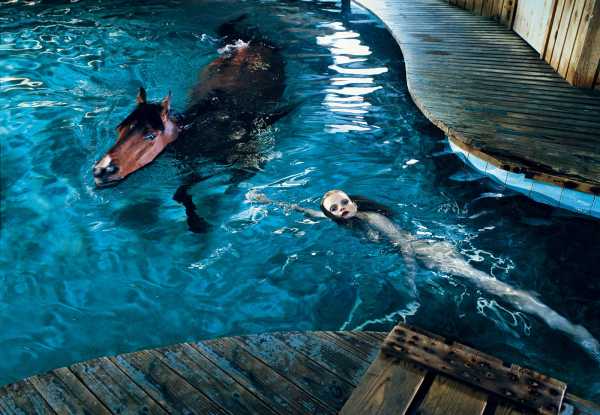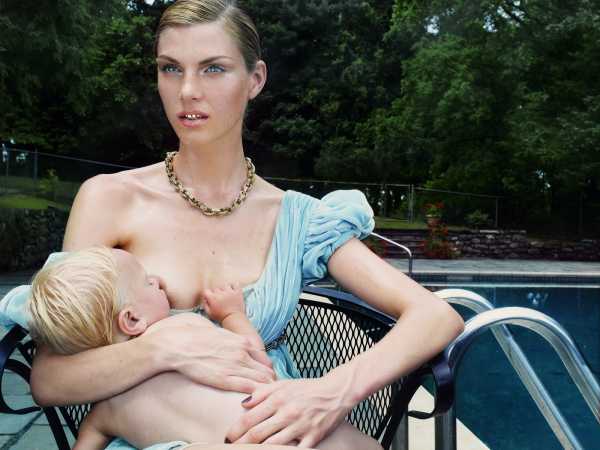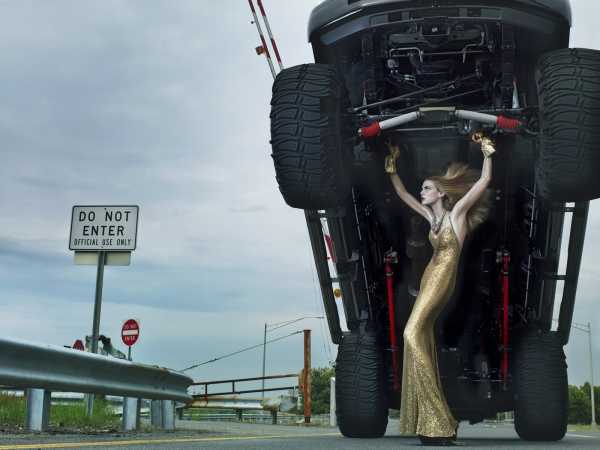
Save this storySave this storySave this storySave this story
“This book I offer you is the book of desire, my dream of leaving my mark on you, in you,” Steven Klein writes in a note at the beginning of his self-titled massive career survey from Phaidon. His words can be read as a warning of sorts: brace yourself. The book—first published late last year and just released in a case-bound, gilt-edged, limited “Luxury” edition—includes several hundred pictures taken over the past three decades; most are printed in a super-saturated color that looks sticky on the page. This selection can only skim Klein’s hyper-prolific œuvre in and outside the editorial pages of Vogue, W, i-D, and Dutch, among other publications. Still, the volume is very deliberately too much; for many viewers, it would feel indigestible at half the size. That’s mostly because Klein’s way of leaving his mark teeters between the seductive and the sadistic: the spectacles he engineers often involve stage blood, gaping wounds, contorted limbs, and gratuitous nudity. Usually, something’s burning; at times, it’s the model.

“Madonna,” St. Regis Hotel, New York City, 2021.
Klein, who is fifty-eight, is the photographer who gave Justin Timberlake a bloody nose, pulled Brad Pitt’s pants down, smothered Kanye West in a plastic bag, and put Madonna in an electric chair, on a stripper pole, and in bed with a group of anonymous studs. (Next to Steven Meisel, her collaborator on the book “Sex,” Madonna has teamed up most regularly with Klein, turning out photographs and films—commercial, promotional, and private—that now constitute a substantial body of work.) His fashion sittings, many on manicured suburban lawns, tend to veer into the absurd and include bizarre masks and prosthetics and incongruous props (a horse, a baby, a pistol, a wheelchair). There’s a comic undertow to much of this: Edward Gorey meets David Lynch. But Klein’s most obvious predecessors on the fashion front, Helmut Newton and Guy Bourdin, were having a lot more fun. Klein’s humor is pitch-black and effortful. The moods he creates are typically dark and ominous; he often seems to be shooting a slasher film rather than a Vogue spread. In Klein’s ritzy version of the horror-movie cul-de-sac, fashion victims are damaged, wounded, left for dead.

“Horse Pool, Guinevere Van Seenus,” Windsor, Connecticut, 2005.

“Suburban Woman No. 10,” 2008.

“Mechanic,” New Jersey, 2006.
In his introduction to Klein’s book, the photographer Mark Holborn writes that “to open this book is to enter criminal territory. Here, the police are busy. Transgression, too, has its allure.” If Klein’s transgression doesn’t seem as thrilling as it once did, you can’t fault the work. It remains tough, subversive, and “difficult” at a time when few magazines—and even fewer advertisers—value anything remotely challenging. Sadly, that makes “Steven Klein” feel like a period piece, a memorial slab to an era when fashion photographers—including Klein, Meisel, Nick Knight, David Sims, Bruce Weber, Collier Schorr, Matthias Vriens, Juergen Teller, and Wolfgang Tillmans—were leading an adventurous, sophisticated, queer-centric avant-garde. They broke old-guard magazines wide open, spearheaded new ones, and changed the way we thought about the medium and the message. Because Klein was one of that group’s most radical members, especially in retrospect, his work looks more outrageous now than it did when it first appeared. How dare he photograph a nude woman with surgical scars on her stomach and breasts as if she were a body dumped on the grass? Or conjure a pregnant male nude, a Los Angeles porn set, a model submerged in a tank like one of Damien Hirst’s sharks, or Tom Ford buffing a man’s bare ass like it was a car hood? Odd to think that this is now history too rude to be repeated.

“Riccardo Tisci,” New York City, 2011.

“Kim Wears Prada, Image No. 15,” Motel 6, Los Angeles, 2014.
Holborn’s introduction describes a short film Klein made for Alexander McQueen that reworked the opening scene from Michael Powell’s 1960 movie “Peeping Tom,” with Kate Moss as the doomed focus of an “obsessive predatory stalker” played by Klein himself. A still from that short, of a small camera clutched in Klein’s tattooed hands like a weapon, is one of the book’s most charged and contained images. Klein is hardly a lone stalker. He has a huge support staff—editors, stylists, hair-and-makeup people—to help realize his obsessions. But his most lurid visions rarely make the editorial pages these days. His transformation of the singer-songwriter Ethel Cain into a vampiric Victorian queen, for the cover of the Spring issue of V, is merely alarming. Subversiveness—the transgressive vision—might be old-school, but Klein hasn’t given it up. His monograph suggests that it’s still a force that can thrill and disturb.

“Underwear Campaign,” Brooklyn, 2004.

“Still Life with Apple and Helmet,” New York, 1996.
Sourse: newyorker.com